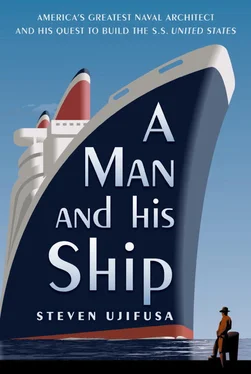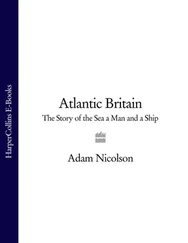The shipyard was also a marvel to behold. William Cramp & Sons had been building cargo ships, passenger liners, and warships for over sixty years. The proud standard bearer for Philadelphia’s industrial might, Cramps employed more than five thousand workers, many of them immigrants from Ireland and Italy. 2In the yard was a towering crane, perched atop a floating barge, that could pick up a seventy-ton boiler and deftly swing it into the hull of a ship over three hundred feet away. Muscular riveters put hulls together by hammering red-hot rivets into steel and iron plates. Roaring orange fires glowed from forges where men shaped mammoth pistons, propellers, and funnels with the precision of watchmakers.
As the music from the band faded into silence, the little boy and the crowd around him awaited the launching of the great ship. Mounting the platform, Cramp handed the first lady a bottle of champagne. The hydraulic rams then hit the ship a bit too early, and the hull started to creep down the ways. Startled, the first lady called out, “I christen thee St. Louis !” and smacked the bottle across the prow before it slid out of reach. 3Picking up speed, the ship roared down the tallow-greased slipway toward the Delaware River, kicking up billows of acrid smoke and, upon hitting the water, sending waves smashing against the banks. Once fully in the river, heavy chains slowed her to a stop. Tugboat crews secured their lines, and she was towed to the fitting-out basin. Her sister ship, St. Paul, remained on an adjacent slipway, to be christened in April of the following year.
At a luncheon after the launch, frock-coated dignitaries toasted the glory of the new American flagship and the presumed rebirth of the nation’s preeminence on the North Atlantic. The American merchant marine—before the Civil War a vast fleet of clippers, whaling ships, and sailing packets—had been in steady decline for decades. An American steamship had not held the transatlantic speed record for half a century. The culprits were lack of government support, a shortage of private capital, and cheaper, subsidized foreign competition.
But to President Cleveland and Clement Griscom, St. Louis represented the dawn of a new era of American maritime might. “We may well be proud because we have launched the largest and most powerful steamship in the Western hemisphere,” the president declared, “built on American plans, by American mechanics, and of American materials.” The two ships would “furnish the revival and development of American commerce and the renewed appearance of the American flag in foreign ports.” 4
To little William Francis Gibbs, the launching of the new ship on that drizzly November day marked the start of a lifelong love affair. He would grow up to build a ship much bigger, faster, and grander than the magnificent St. Louis.
“That was my first view of a great ship and from that day forward I dedicated my life to ships,” William Francis Gibbs later recalled. “I have never regretted it.” 5
The size, beauty, and luxury of the nineteenth-century ocean liner captivated the public, but even more alluring was speed. “Speed is the only thing which they talk, think, or dream of anywhere between Sandy Hook and Roche’s Point,” the New York Times said about American passengers in 1883. “Whenever their vessel distances some other steamship which is bound in the same direction, they are thrown into ecstasies.” 6Shipbuilders were just as obsessed with speed. “Each successive lowering of the record,” boasted Philadelphia’s Cramp Shipyard, “marks a triumph for the designer and builder, a fame world-wide, and substantial benefits to mankind.” 7
This speed record was known as the “Blue Riband of the Atlantic,” a mythic-sounding prize developed in the middle of the nineteenth century and awarded to the fastest steamship sailing between the old and new worlds. Because actual miles traveled varied from voyage to voyage, the unspoken rule was to award the Blue Riband not to the ship making the quickest trip, but to the one achieving the highest average speed in nautical miles per hour, or knots (1.15 land miles per hour). [2] One knot is the equivalent of 1.15 land miles per hour. Thirty-three knots, or 33 nautical miles per hour, translates to about 37 miles per hour. But land measures don’t give a full picture of the speed involved when moving through water. The fastest nineteenth-century sail-powered clipper ships could average 16 knots; the great aircraft carriers of World War II averaged about 32 knots. The Cunard liner Queen Mary held the Blue Riband for the fastest Atlantic crossing from 1938 to 1952, averaging just over 30 knots.
Prevailing winds and currents made the westbound crossing, from Europe to America, more difficult than the one eastbound. So the Blue Riband was divided into two prizes: one for the westbound record and another for the eastbound; the former, more arduous crossing, carrying more prestige. There was no set course, but the generally accepted rule was that the clock started when the ship left its last port of call and achieved full cruising speed—usually off the southwest tip of England—and ended at the entrance to New York harbor, either at Sandy Hook or Ambrose Lightship, when she had to slow down. What started as an advertising ploy quickly grew into an international contest into which steamship companies, engineers, and governments poured talent and money.
It was the advent of steam that allowed oceangoing passenger ships to keep regular schedules, and the first commercially successful steamship was an America creation. In 1807 Robert Fulton’s steamboat Clermont, plying the Hudson River, cut the travel time from New York to Albany from three days down to thirty-two hours, and could make regularly scheduled departures regardless of wind and currents. Twelve years later, an enterprising group of businessmen from Savannah, Georgia, outfitted a small sailing ship with a crude steam engine and paddle wheels and sent her across the Atlantic. Savannah ’s epic voyage, even if only made partially under steam, was a landmark in maritime history, but American businessmen decided that steamships were best used on inland and coastal routes. The ocean remained the domain of the sailing ships, most notably the clippers, which journeyed around Cape Horn to the gold fields of California and the tea and spice hubs of East Asia.
It was a different story for the British, whose fortunes were tied to the overseas wealth generated by its far-flung colonies. For the British government, supporting this new transportation technology—steamships that could carry passengers, mail, and cargo on a regular schedule—was a matter of imperial necessity. Not only that, but there were fortunes to be made carrying immigrants in steerage to the United States and Canada. In 1839, Samuel Cunard, an enterprising colonial who moved to England from Nova Scotia, finagled a British government subsidy of £60,000 a year to start a transatlantic steamer line that would carry the mails. 8Cunard’s first ship, Britannia —a two-hundred-foot-long, wooden paddle-wheel steamer with a top speed of 8.5 knots (about 10 land miles per hour)—made its first voyage between Liverpool, Halifax, and Boston in July 1840. Service to New York began in 1857. Cunard’s ships cut a typical Atlantic crossing time down from two months under sail to a mere two weeks under steam. For Samuel Cunard, safety and reliability trumped luxury. Cabins were cramped, furnishings plain, and cuisine bland at best. As his partner Charles MacIver once made clear to an unhappy passenger, “Going to sea is a hardship.” 9
The transition from sail to steam made crossings faster, but not necessarily more pleasant; the North Atlantic was still arguably the most treacherous body of water on the planet. Except for a brief sunny summer interlude, passengers boarding a liner in Liverpool bound for New York expected gray skies, heaving seas, and blustery winds during most of the voyage. During the depths of winter, spitting rain, howling gales, and monster waves would punish the steamship, send furniture and clothing flying through the air, and make everyone on board seasick. And then when the ship reached the Grand Banks, off the Canadian coast, thick fog would often roll in, making visibility close to zero. Most passengers were more than happy to stumble ashore after enduring two weeks of cramped quarters and nausea aboard a Cunard steamer.
Читать дальше












